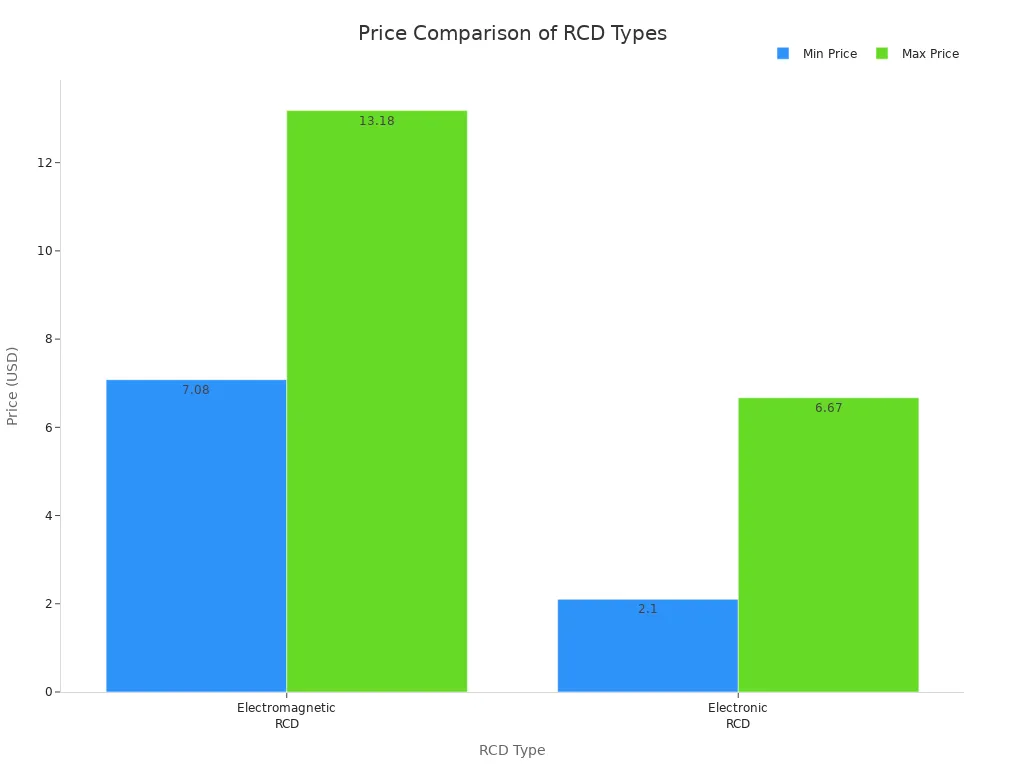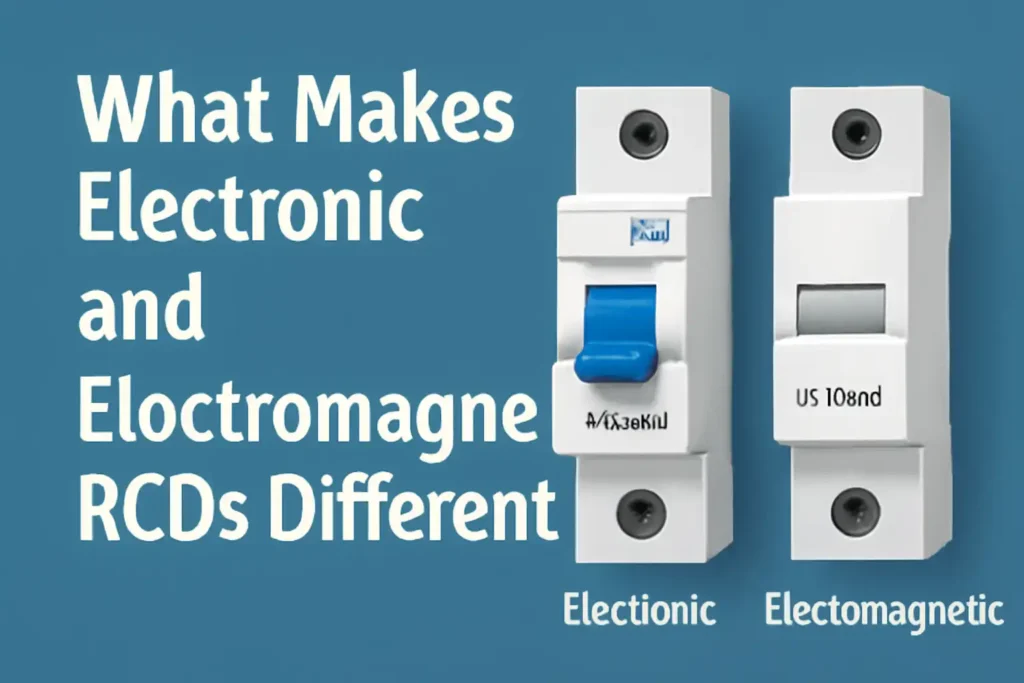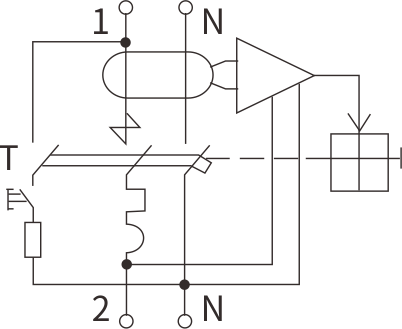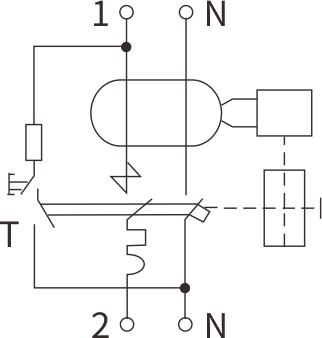You see the main difference between electronic and electromagnetic RCDs in how they work and where they get power. Electronic types use electronic circuits. They need power from outside to work. Electromagnetic types use magnetic coils. They can work even if the power goes out. This difference changes how safe and reliable your RCD is.
Picking the right one helps you keep your home or workplace safe from electrical dangers.
Key Takeaways
- Electronic RCDs need power from outside. They work best in homes with steady electricity.
- Electromagnetic RCDs do not need outside power. They protect better when the power goes out or is not steady.
- Pick RCDs based on where you live, what devices you use, and how steady your power is. This helps keep you safe from electrical problems.
- Test your RCD every three to six months. This makes sure it works right and keeps you safe.
- Always have a trained electrician put in or change RCDs. This gives you the best safety and performance.
How RCDs Work
Electronic Type
An electronic type RCD helps protect you from electrical problems. It uses electronic circuits and needs power from outside to work. Inside, there is a toroidal transformer. The live and neutral wires go around the core in opposite ways. When things are normal, the currents in both wires are equal. No magnetic flux shows up in the core, so the device does nothing.
If an earth fault happens, the currents in the wires are not equal anymore. This makes a magnetic flux in the toroid. The flux causes a current in a special coil that detects it. The electronic circuit notices this current and turns on a relay fast. The relay trips the RCD and stops the electricity to keep you safe. This idea works for single-phase and three-phase systems. Electronic RCDs follow strict rules to make sure they work right when there is a fault.
Tip: Electronic RCDs need power all the time. If the power goes out, the device might not trip when there is a fault.
Electromagnetic Type
Electromagnetic RCDs work in another way. These devices use magnetic coils and do not need outside power. The main coil and neutral coil wrap around a toroidal core with a search coil. When things are normal, the currents in the wires are the same. No magnetic flux appears.
If earth leakage happens, the currents in the wires are not the same. This makes a magnetic flux that causes a voltage in the search coil. The voltage starts the tripping circuit. The trip coil disconnects the circuit very fast. This keeps you safe from electric shock or fire. Electromagnetic RCDs can sense very small leakage currents. They work even if the main power goes out.
- You can use electromagnetic RCDs in places where power goes out a lot.
- These devices need a good earthing system to work safely.
RCD Key Differences
Power Source
The biggest difference is how each RCD gets power.
- Electronic RCDs use electronic circuits. They need power from outside to work. If the power goes out, they might not trip.
- Electromagnetic RCDs use a magnetic trip system. They do not need outside power. They can work even if the main power fails or there is a problem with the lines.
- Electromagnetic RCDs handle voltage drops and phase loss better. You can trust them more in places with unstable power.
Tip: If your area has lots of power cuts or voltage problems, electromagnetic RCDs protect you better.
Sensitivity
Sensitivity means how well an RCD finds small leakage currents.
- Electronic RCDs have higher sensitivity. They can find very small leaks, even ones with DC parts. Some trip at just 30 mA, which matches their rated trip current.
- Electromagnetic RCDs are less sensitive to DC currents. They may not trip if a sudden DC current shows up. These work best for slowly rising leaks.
- The core inside an electromagnetic RCD affects its sensitivity. Low remanence magnetic cores help detection but are still not as good as electronic types.
Here is a table showing typical sensitivity ranges:
| Sensitivity Category | Typical Rated Residual Operating Current (IΔn) | Typical Application |
|---|---|---|
| High Sensitivity | 5 mA, 10 mA, 30 mA | Life protection (direct contact or injury prevention) |
| Medium Sensitivity | 100 mA, 300 mA, 500 mA, 1000 mA | Fire protection |
| Low Sensitivity | 3 A, 10 A, 30 A | Machine protection |
Reliability
Reliability means how well an RCD works over time and in tough places.
- Electronic RCDs need steady power. If the power fails or drops, they might not trip. This makes them less reliable in places with unstable electricity.
- Electromagnetic RCDs work without outside power. They use energy from the fault current to trip. This makes them more reliable during power outages or voltage changes.
- Studies show RCDs can fail between 3% and 8% of the time. There is no clear data on which type fails more. You should test your RCD often to make sure it works.
Note: International rules say you must check your RCDs often to keep your electrical system safe.
Environmental Suitability
Think about where you will use your RCD.
- Electronic RCDs work well in modern homes and offices with steady power. They do not need a special earth connection.
- Electromagnetic RCDs are good for places with lots of power cuts, voltage drops, or tough conditions. They need a good earth connection to work safely.
- Electronic types are less likely to trip by mistake from voltage changes. Electromagnetic types may trip more if the voltage changes quickly.
Here is a quick comparison:
| Feature | Electromagnetic RCD | Electronic RCD |
|---|---|---|
| Power Source | No external power needed | Needs external power |
| Sensitivity | Lower, less for DC | Higher, detects small DC leaks |
| Reliability | High in unstable power | High in stable power |
| Earth Connection | Required | Not required |
| Nuisance Tripping | More likely | Less likely |
| Best Use | Harsh, unstable environments | Modern, stable installations |
RCD Comparison Table
It is important to know how RCDs are different. The table below helps you see these differences quickly. You can compare electronic and electromagnetic RCDs side by side. This helps you choose the best one for your needs.
| Feature | Electromagnetic RCD | Electronic RCD |
|---|---|---|
| Operation | Uses magnetic coils, works without extra power | Uses electronic circuits, needs outside power |
| Sensitivity | Good for AC faults, less for DC leaks | High, detects small AC and DC leaks |
| Reliability | Very reliable during power cuts or voltage drops | Reliable in stable power, less so in outages |
| Cost | Higher upfront, lasts longer | Lower upfront, may need replacement sooner |
| Best Use Cases | Factories, outdoor sites, unstable power areas | Homes, offices, places with steady electricity |
Electromagnetic RCDs protect you better in tough places. Electronic RCDs work well in homes with steady power.
Cost Comparison
You might want to know about the price. Surveys show electromagnetic RCDs cost more at first. They last longer and handle problems better. Electronic RCDs cost less, so they are good for small budgets. You may need to replace them sooner.
| RCD Type | Example Product | Price Range (USD) | Key Attributes |
|---|---|---|---|
| Electromagnetic RCD | KEDU CKDL1G Electromagnetic RCCB | $7.08 – $13.18 | High durability, premium, robust |
| Electronic RCD | 2P RCCB, AC Type RCD (various models) | $2.10 – $6.67 | Cost-effective, common, shorter lifespan |

If you need an RCD for places with many power cuts, pick electromagnetic types. If you want to save money and have steady power, electronic RCDs may be better for you.
Choosing an RCD
Home Use
When you pick an RCD for your house, think about your wiring and what devices you have. Most houses use Type AC RCDs. These find normal AC faults. They work well for things like lights and outlets. If you have new electronics like computers or LED lights, you should look at Type A or Type B RCDs. These can find both AC and DC faults. Newer devices often make DC faults.
| RCD Type | What It Detects | Where to Use |
|---|---|---|
| Type AC | AC faults | Most homes |
| Type A | AC + Pulsating DC | Homes with electronics |
| Type B | AC + All DC | Homes with solar panels or EV chargers |
Tip: Press the test button on your RCD every three to six months. This helps keep your house safe.
For wet places like bathrooms or outside, use RCDs with 30 mA sensitivity. These help stop electric shock and lower fire risk. Always let a trained electrician put in and check your RCDs.
Industrial Use
Factories and workshops have different needs. Machines can make small leaks that trip normal RCDs. Use low-sensitivity RCDs (over 500 mA) to stop unwanted shutoffs. Type B RCDs are best for places with inverters or speed drives. These can find both AC and DC faults and work with tricky machines.
| Reliability Concern | What to Watch For |
|---|---|
| Nuisance Tripping | Use low-sensitivity RCDs |
| Harsh Environments | Pick rugged, certified RCDs |
| System Coordination | Use time-delayed RCDs for selectivity |
Note: Always pick RCDs that follow IEC or local safety rules. Test them every few months to make sure they work.
Special Cases
Some places need extra care when you choose an RCD. If you are near big motors or radio gear, use RCDs with filters or delayed response. These help stop false trips from surges or noise. For outside or wet spots, use weatherproof RCDs and test them often.
- Use portable RCDs if you cannot put in a fixed one.
- Always follow local rules and get a pro to install your RCD.
- For hospitals or important places, ask an expert. There are no special RCDs just for these, but testing and reliability matter most.
Safety Tip: Test your RCD often and install it right. This keeps you safe from harm.
Now you understand how electronic and electromagnetic RCDs are different.
- Electronic RCDs are good for homes where power is steady.
- Electromagnetic RCDs keep you safer if power goes out a lot or the place is tough.
You should always talk to a trained electrician before putting in or changing any RCD. This helps keep you and your things safe.
FAQ
What happens if you use the wrong type of RCD?
You risk poor protection. The wrong RCD may not trip during a fault. You could face electric shock or fire. Always match the RCD type to your environment and devices.
What makes electromagnetic RCDs better for unstable power?
Electromagnetic RCDs work without outside power. They trip even if the main power fails. You get more reliable protection in places with frequent outages or voltage drops.
What should you check before installing an RCD?
You should check your wiring, earth connection, and the type of devices you use. Make sure the RCD matches your needs. Ask a qualified electrician for help.
What is the main reason electronic RCDs fail?
Electronic RCDs need outside power. If the power supply fails, the RCD may not trip. You lose protection during blackouts or voltage drops.
What is the best way to test your RCD?
Press the test button on your RCD every three to six months. This checks if the device trips correctly. If it does not trip, replace it or call an electrician.
See also
Difference between electromagnetic and electronic RCCB
Type 1 and Type 2 surge devices explained in 5 steps
How to Prevent Shocks with RCD for Electric Vehicle Charging
Comparison between residual current device and GFCI
How to Choose the Right RCD for Your Home or Business





